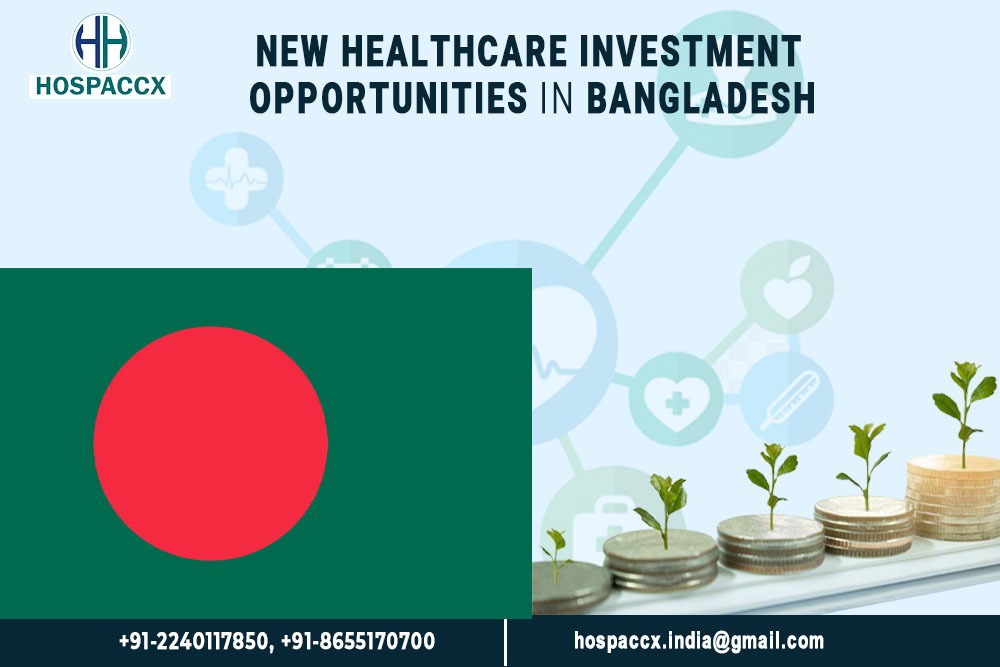New Healthcare Investment Opportunities in Bangladesh
An important contributor to the economy and wellbeing of the society, the Bangladesh healthcare industry has been progressing swiftly in recent years. Growing at a CAGR of 10.3% percent since 2010, the size of the healthcare industry has reached USD 6.76 billion in 2018 (in terms of spending on the healthcare expenditure). The sector consists of healthcare services by hospitals, clinics, diagnostic centres, including digital healthcare services, clinical researches, as well as medical device manufacturing and trade/ distribution.
Economic and Financial Snapshot of Healthcare in Bangladesh
Bangladesh, the world’s 57th biggest economy, has made substantial socioeconomic progress in recent years. Over the last decade, GDP has grown at a 6-7 percent annual rate. Nonetheless, despite increasing healthcare metrics such as lower death rates and an increase in average life expectancy, the country’s health system has yet to fulfil its full potential. Total healthcare spending accounts for only 3.7 percent of the economy’s total GDP.
Investment Growth Potential
The Bangladesh government values the significance of health towards building a healthy and productive population. Over time, the country has made great progress in improving life expectancy, reducing infectious disease, infant and maternal mortality, and is the only least developed country (LDC) that meets nearly 98 percent of its domestic demand for pharmaceutical products, with a market size of approximately $3 billion.
Large domestic market with greater affordability: Bangladesh’s demand for healthcare services is predicted to grow substantially, owing to rising buying power. According to the Boston Consulting Group, by 2025, 30 to 40 million individuals will have graduated from poverty to the entry-level of the middle class, with another 30 million moving up the economic ladder to a higher quality of life. This improvement in affordability, along with the existing low per-capita healthcare spending, shows that the healthcare industry has room to develop in the future. While per-capita healthcare spending in Bangladesh has increased at a 9 percent compound annual growth rate (CAGR) since 2013, it is still just USD 42 in 2018, which is low when compared to regional counterparts, signalling the potential to boost healthcare spending as wealth improves.
Sustained demand with population growth: As birth rates decline and life expectancy rises, the senior population is expected to expand over time, necessitating a significant increase in healthcare demand. Bangladesh had about 13 million persons over the age of 60 as of 2019. By 2050, this age group is expected to grow to 42 million people (BBS, 2015).
Changing disease profile: Bangladesh has seen a significant shift in disease patterns, with noncommunicable diseases (NCDs) being the primary cause of death, resulting in an increased need for healthcare services. NCDs were responsible for 67 percent of fatalities in 2016. The biggest cause of death (30%) was cardiovascular disease, followed by cancer (12 percent ). Every year, an estimated 200,000 people are diagnosed with cancer for the first time. Diabetes is another important ailment that affects 9% of the population and is expected to rise to 13% by 2030, according to the World Bank Group (according to the research by International Diabetes Federation). Furthermore, mental health has become a concern in Bangladesh that cannot be ignored.
Healthcare Investment Opportunities
Medi-tech services: With over 112 million internet users in the nation, tele-healthcare has a huge potential to reach a large portion of the population, both in cities and small communities. According to a study conducted by a local digital health service provider, online consultation can resolve 80-90 percent of primary care consultation cases. For such reasons, a number of companies have emerged to offer online services such as doctor directory/appointment scheduling and personal medical history recording. Furthermore, the COVID epidemic has increased the need for telemedicine/e-pharmacy by altering customer behaviour and making online consultations more acceptable. According to another study (by Light Castle), the medi-tech industry is one of Bangladesh’s most prospective investment categories.
Health insurance: Bangladesh has one of the highest out-of-pocket spending rates (as a proportion of overall healthcare spending) in the world, with families covering about 74 percent of total health spending. Furthermore, according to Swiss Re, a worldwide insurer, Bangladesh’s total insurance penetration in 2018 was 0.6 percent, the lowest among Asian countries. Bangladesh’s health insurance business has the potential to develop as the government plans to expand universal healthcare coverage by 2032. Foreign investors can play an important role in the development of health insurance services.
Pharmaceutical Industry: $1.0 billion have been invested in the country’s pharma industry within the last five years for capacity expansion or upgradation as the sector is enjoying various policy support including favourable provisions in the National Drug policies, recognition as a thrust sector, and incentive on export.
Medical equipment manufacturing: It goes without saying that the expansion of healthcare institutions drives demand for medical equipment. Between 2016 and 2019, the Bangladeshi medical industry grew at a pace of 14.6 percent per year, the world’s fastest, and is predicted to continue growing (according to Business Monitor International Research). The move to NCDs, which need surgery and long-term therapy, is likely to drive medical device demand. While local manufacture of medical devices and equipment is still in its infancy and restricted to lower-risk items, there is a significant opportunity to expand medical device manufacturing locally. Local makers of devices and equipment can explore the export market in addition to domestic use, with preferential access to as many as 52 countries for sale.
Establishment of tertiary/specialized hospitals: Despite the fact that the number of healthcare institutions in Bangladesh has increased over the previous decade, demand for hospital beds has constantly surpassed supply. In 2016, the available bed density per 1,000 inhabitants was 0.8, which is low by worldwide standards. This data demonstrates the unmet demand for tertiary/secondary hospital facilities, which foreign investors are encouraged to contribute to. Furthermore, the shifting illness profiles in Bangladesh are driving up the need for tertiary or specialist hospitals that treat noncommunicable diseases.
Conclusion
Bangladesh is a winning combination with its high disease burden, competitive market, business-friendly environment and competitive cost structure that can give you best returns. The country is strategically located in between India, China and ASEAN markets, and as the South Asian Free Trade Area (SAFTA) comes into force, investors in Bangladesh enjoy duty-free access to India along with EU, Japan and major developed countries.
The Bangladesh government is proactively pursuing international investment, notably in the energy and infrastructure sectors. Many incentives have been adopted through industrial policy, the export growth plan, and the public-private partnership (PPP) programme, which was established in 2009.
For more information about the Country and Healthcare opportunities in Bangladesh, you can visit the company website on www.hospaccxconsulting.com or contact us directly.
Related Team Members










